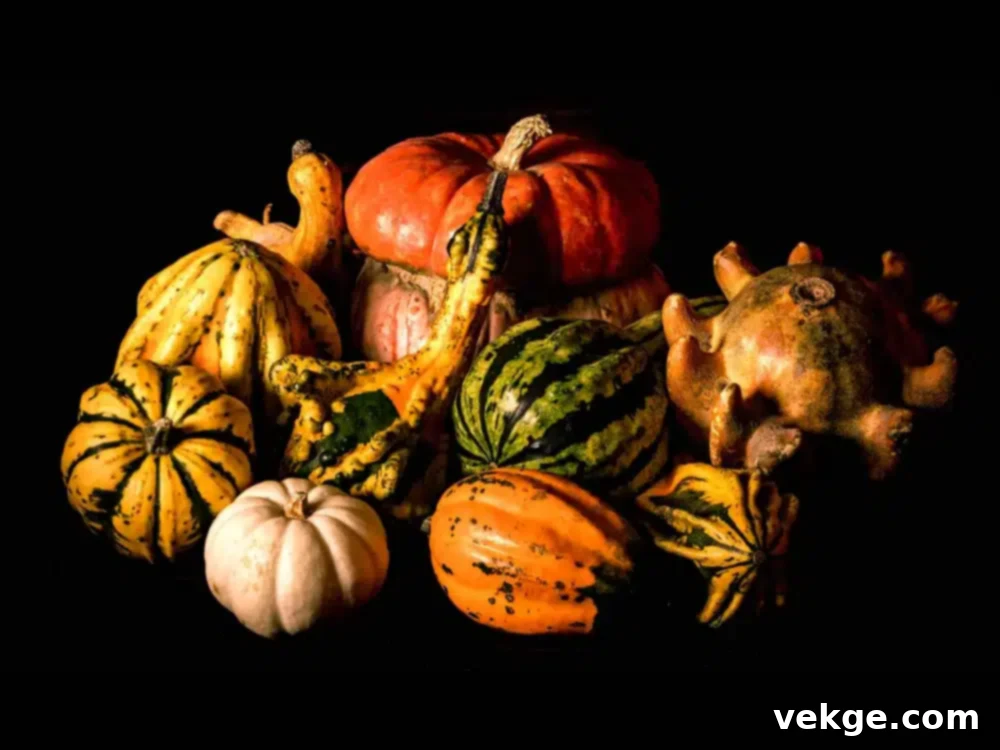Discover the Bounty of Autumn: A Comprehensive Guide to Fall Gourds and Squashes
As the vibrant hues of green give way to fiery reds, oranges, and yellows, and a crisp coolness fills the air, autumn ushers in a beloved tradition: the season of gourds and squashes. These delightful fall favorites offer much more than just seasonal charm; they are a cornerstone of autumn cuisine, a powerhouse of nutrition, and an endless source of decorative inspiration. But what exactly makes them so cherished and versatile?
From the instantly recognizable bright orange pumpkin that graces our doorsteps and holiday tables, to the oddly shaped turban squash, and the smooth, sweet butternut, each unique gourd and squash variety brings its distinct flavor, texture, and aesthetic appeal to fall celebrations and meals. These botanical wonders come in an astonishing array of shapes, sizes, and colors, each with its own special qualities waiting to be discovered.
In this comprehensive guide, we will embark on a fascinating journey through the world of various fall gourds and winter squashes. We’ll delve into their culinary applications, providing delicious ideas for incorporating them into your cooking. We’ll explore their remarkable health benefits, highlighting the essential nutrients they offer. Furthermore, we’ll share creative ways to use them to enhance your home’s autumn decor, transforming simple vegetables into festive displays. Our aim is to equip you with all the knowledge you need to fully appreciate and maximize the potential of these incredible fall treasures.
Prepare to become a gourd and squash connoisseur! We’ll show you how to select the freshest specimens, prepare them into delectable dishes, and utilize them to make your autumn season more flavorful, healthier, and undeniably beautiful. Let’s dive into the colorful world of fall’s finest produce!
1. Pumpkin: The Iconic Autumn Staple
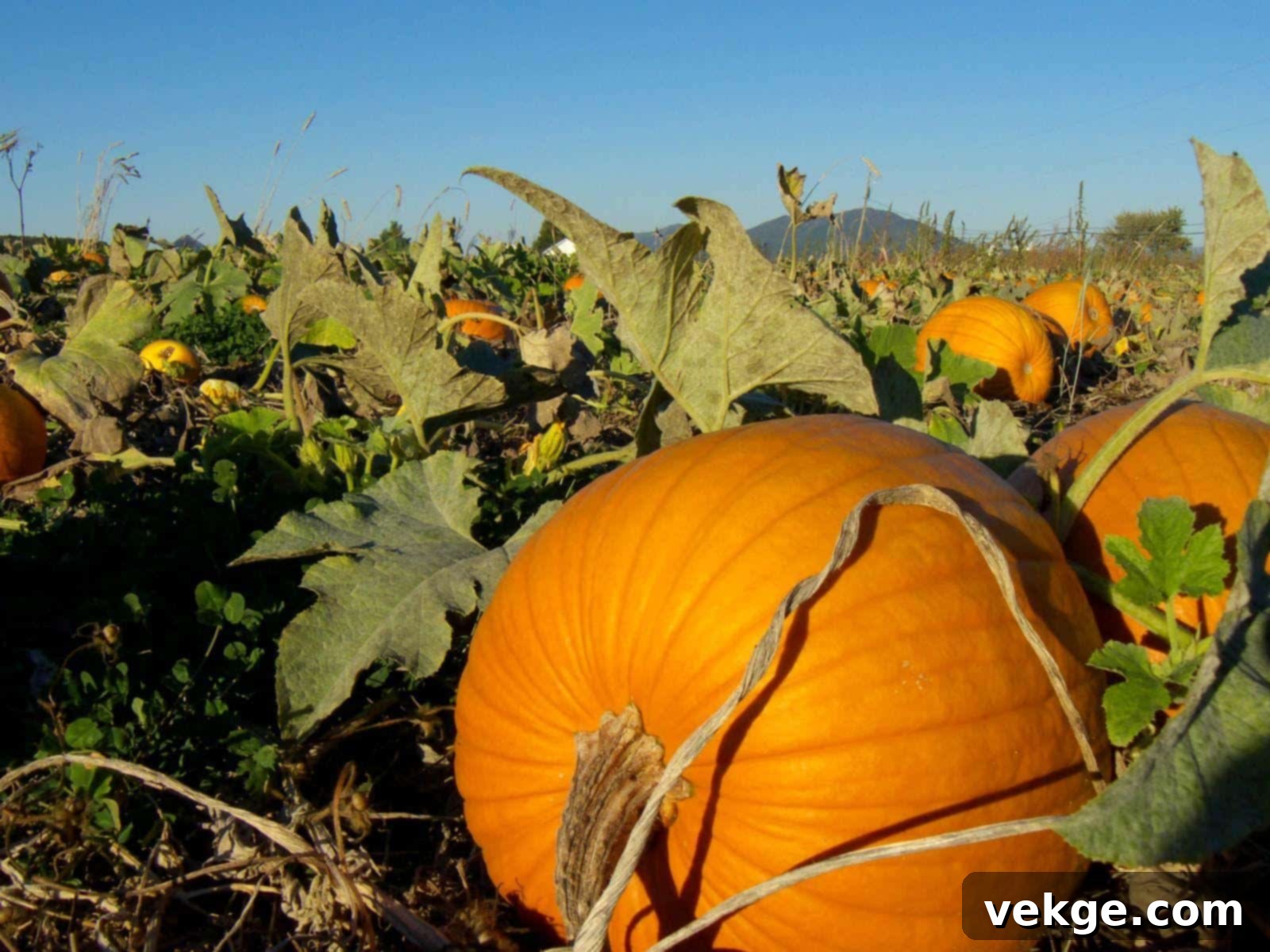
The pumpkin is arguably the undisputed symbol of autumn, synonymous with Halloween, Thanksgiving, and cozy fall days. Beyond its iconic status, the pumpkin boasts incredible diversity. Varieties like the ‘Sugar Pie’ or ‘New England Pie’ pumpkins are small, dense, and wonderfully sweet, making them ideal for baking and culinary uses. In contrast, ‘Atlantic Giant’ pumpkins can grow to colossal sizes, becoming the stars of harvest festivals and carving competitions. There are also ornamental types like ‘Cinderella’ or ‘Jarrahdale’ which offer unique colors and shapes for decorative purposes.
In the kitchen, pumpkins truly shine. They are incredibly versatile, lending themselves to both sweet and savory dishes. Create a timeless classic with a homemade pumpkin pie, or blend its creamy flesh into a rich, warming soup perfect for chilly evenings. For a simple yet flavorful side dish, roast pumpkin chunks with aromatic herbs like sage and rosemary, a drizzle of olive oil, and a sprinkle of sea salt. Don’t forget the seeds! Roasted pumpkin seeds, seasoned with your favorite spices, make a crunchy and nutritious snack.
Pumpkins are also a nutritional powerhouse. They are packed with beta-carotene, which your body converts into Vitamin A, essential for excellent eye health, robust immune function, and healthy skin. They are also a good source of dietary fiber, aiding digestion and promoting satiety, and contain valuable antioxidants that may help protect your cells from damage and reduce the risk of certain chronic diseases. Plus, they offer a good dose of Vitamin C, potassium, and several B vitamins.
For seasonal fun, pumpkin carving remains a beloved tradition. Unleash your creativity by crafting spooky faces, intricate patterns, or whimsical designs. If carving isn’t your style, or for a mess-free alternative, simply paint your pumpkins. Arrange different sizes, shapes, and colors of uncarved pumpkins on your porch, mantel, or as a centerpiece for a charming and effortless fall display that celebrates the bounty of the harvest.
2. Butternut Squash: The Sweet and Versatile Favorite
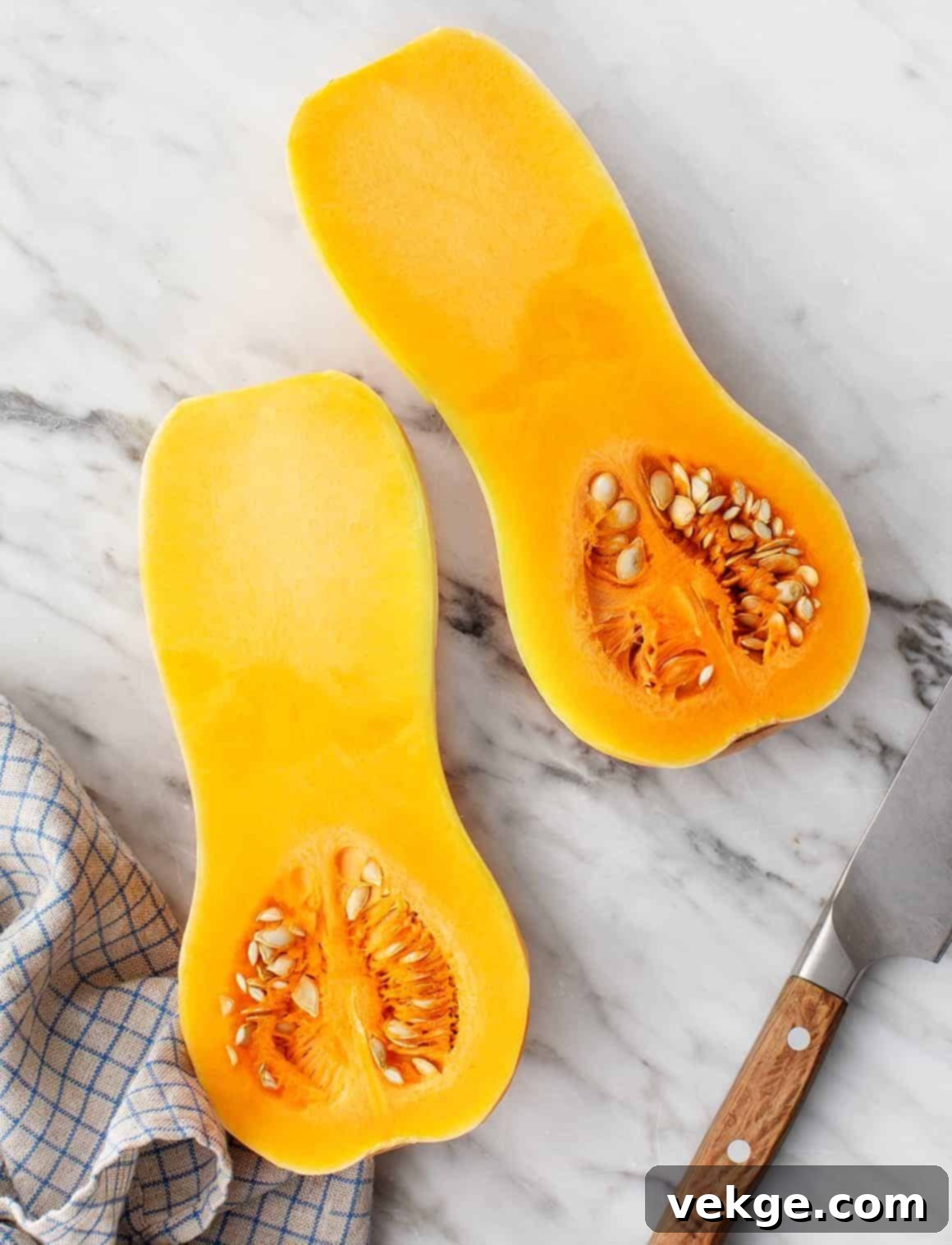
Butternut squash, with its distinctive bell shape and pale, tan skin, is a culinary darling for good reason. Its sweet, nutty flavor and creamy texture make it exceptionally versatile. When selecting a butternut squash, look for one that feels heavy for its size, indicating dense flesh and good moisture content. The skin should be dull, uniform tan, and free from any soft spots, green patches, or deep cuts, which can signal spoilage. A firm stem is also a good indicator of freshness. Uncut, butternut squash can be stored in a cool, dry place away from direct sunlight for up to three months, making it an excellent pantry staple.
Preparing butternut squash is straightforward. Begin by carefully cutting it in half lengthwise, then scoop out the seeds and fibrous strands. For roasting or baking, you can place the halves cut-side down on a baking sheet. Alternatively, you can peel the squash with a sturdy vegetable peeler or sharp knife, then cube it before cooking. For a luxuriously smooth texture, cooking and then pureeing the squash yields a silky base for many dishes. Roasting enhances its natural sweetness and deepens its flavor profile.
Butternut squash excels in a variety of culinary creations. It makes a divine soup when blended with warming spices like ginger, nutmeg, and cinnamon, perhaps with a hint of coconut milk for richness. It’s also an excellent addition to creamy risottos, adding a delightful sweetness and vibrant color. Get creative by incorporating it into pasta sauces, wholesome curries, or even healthy baked goods like pies, muffins, or quick breads for a nutritious and flavorful twist on dessert. It pairs beautifully with apples, pecans, and maple syrup.
This humble squash is packed with an impressive array of nutrients. It’s an outstanding source of beta-carotene, converting to a significant amount of Vitamin A, crucial for vision, immune function, and skin health. It also provides a substantial amount of Vitamin C, a powerful antioxidant, and is a good source of dietary fiber, potassium, and several B vitamins, all contributing to overall well-being and a balanced diet. Its high water content and fiber make it surprisingly filling, aiding in weight management.
3. Acorn Squash: The Perfect Individual Serving

Acorn squash, named for its distinctive acorn-like shape and ridged dark green skin, is renowned for its tender, slightly sweet, and nutty flesh. It’s particularly popular for its convenience as an individual serving vessel. Baking is a fantastic way to prepare acorn squash: simply cut it in half, scoop out the seeds, and bake cut-side down until the flesh is fork-tender. This method ensures even cooking and retains moisture. For a complete and satisfying meal, acorn squash halves can be gloriously stuffed with a variety of fillings, such as grains (like quinoa or wild rice), ground meats, savory sausages, sautéed vegetables, or a combination of them all, creating a beautiful and wholesome presentation.
The mild, subtly nutty taste of acorn squash makes it incredibly versatile and pairs harmoniously with a wide range of flavors. For a classic sweet preparation, try baking it with a pat of butter and a spoonful of brown sugar, or a drizzle of pure maple syrup and a sprinkle of warm cinnamon or nutmeg. For a more savory profile, it marries beautifully with aromatic herbs like sage, thyme, or rosemary, perhaps with some garlic and a splash of chicken or vegetable broth. A touch of cayenne pepper can also add a delightful kick. Its natural sweetness means it doesn’t need much to be delicious.
When serving, leaving the cooked squash in its skin offers not only a rustic charm but also creates a natural, edible “bowl” for your chosen stuffing. This makes for an elegant and inviting presentation on the plate, perfect for a cozy family dinner or a festive gathering. The skin, while edible, is typically not consumed by most as it can be a bit tough, but it certainly makes for a sturdy serving dish.
Acorn squash is not just delicious; it’s also remarkably good for you. It’s an excellent source of dietary fiber, which is vital for digestive health, promoting regularity and contributing to feelings of fullness. It also provides a significant amount of Vitamin C, a crucial antioxidant, and important minerals such as potassium, which supports heart health and blood pressure regulation, and magnesium. Furthermore, it contains various antioxidants that help protect your body’s cells from oxidative stress and damage, contributing to long-term health and well-being.
4. Spaghetti Squash: The Noodle Alternative
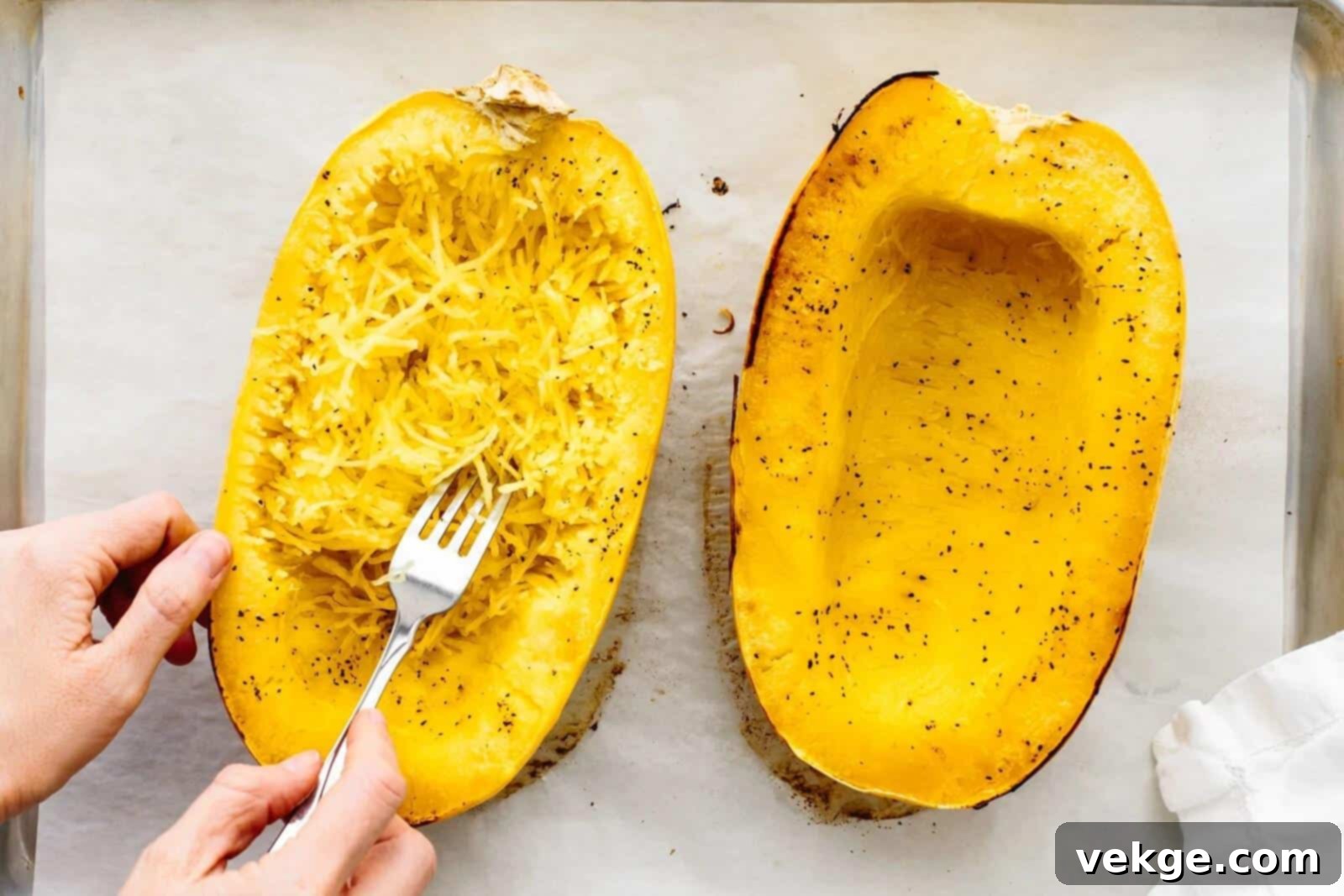
Spaghetti squash is a unique and wonderfully healthy squash, famous for its ability to transform into pasta-like strands when cooked. Its mild flavor makes it a fantastic canvas for a myriad of sauces and seasonings. To prepare spaghetti squash, the most common method is to cut it in half lengthwise, scoop out the seeds, and then bake it cut-side down in the oven until the flesh is tender. Once cooked, simply use a fork to gently scrape and pull out the stringy flesh – it magically separates into strands that truly resemble spaghetti noodles! It can also be cooked whole in the microwave or Instant Pot for a quicker preparation.
This ingenious squash is an absolute boon for anyone looking to reduce their carbohydrate intake or simply incorporate more vegetables into their diet. It serves as an excellent, low-calorie, and nutrient-dense alternative to traditional pasta in almost any dish. Top your “spaghetti” squash with your favorite marinara sauce, a sprinkle of Parmesan cheese, and fresh basil for a lighter, yet incredibly satisfying meal. You can also mix it with sautéed vegetables, grilled chicken, or lean ground meat for a hearty and wholesome dish that won’t weigh you down. It’s also delicious as a base for stir-fries, or baked into casseroles.
Proper storage is key to enjoying spaghetti squash throughout the season. Keep uncut spaghetti squash in a cool, dry place, such as a pantry or cellar, where it can last for up to three months or even longer if conditions are ideal. Once cooked, any leftovers should be stored in an airtight container in the refrigerator and consumed within 3-5 days to maintain freshness and prevent spoilage. Cooked spaghetti squash can also be frozen for longer storage, making meal prep easier.
Spaghetti squash offers significant health benefits, especially for those mindful of their caloric intake or looking to manage weight. It is notably low in calories but surprisingly filling due to its high water and fiber content. It provides a good source of essential vitamins and minerals, including Vitamin C, Vitamin B6, manganese, and potassium. Its rich fiber content aids in healthy digestion, helps stabilize blood sugar levels, and contributes to a feeling of fullness, making it an excellent choice for a healthy, balanced diet.
5. Kabocha Squash: The Japanese Pumpkin
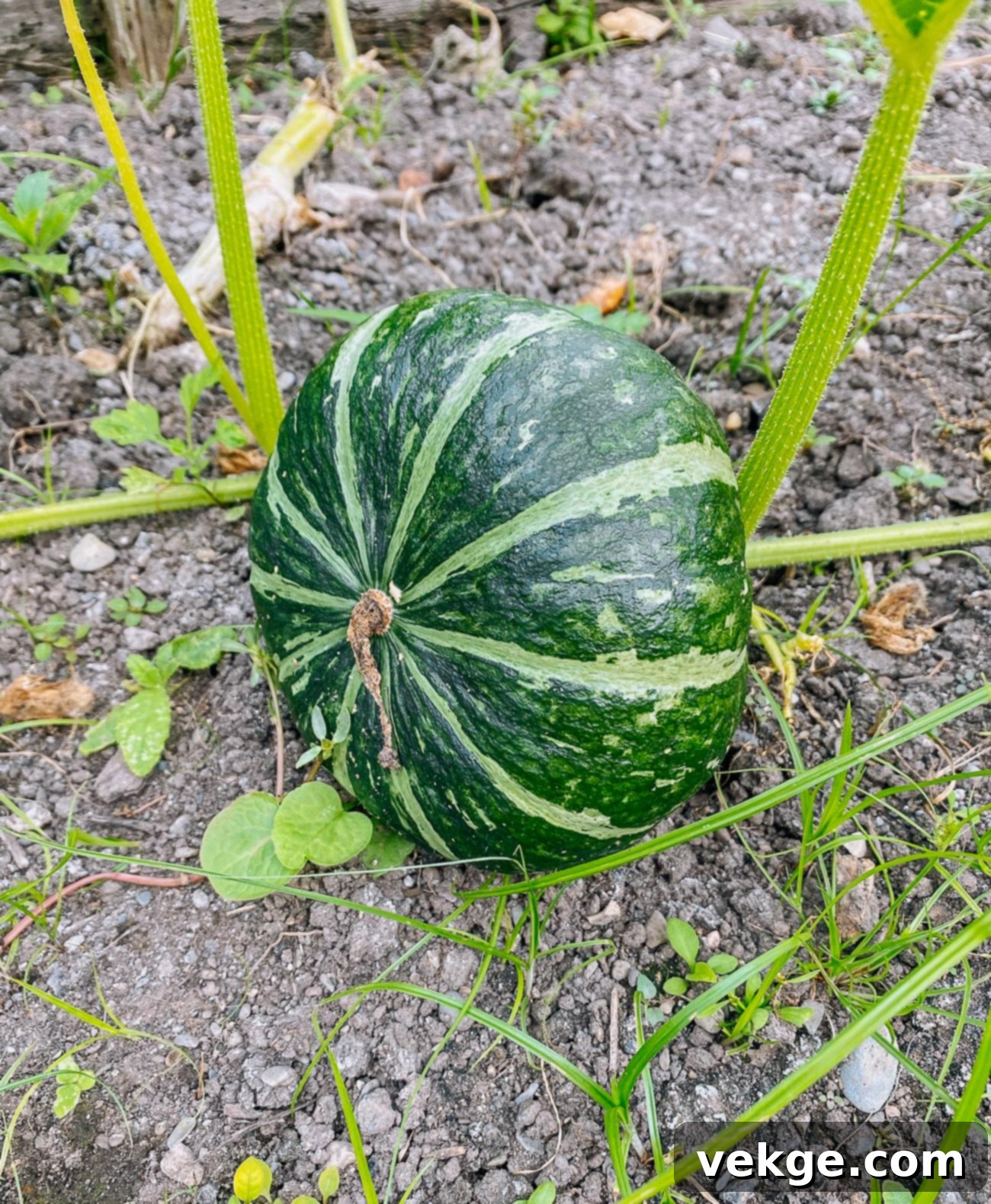
Kabocha squash, often referred to as “Japanese pumpkin,” is a culinary gem cherished for its incredibly sweet, subtly nutty flavor and remarkably creamy, almost fluffy texture. Many describe its taste as a delightful cross between a sweet potato and a pumpkin, with hints of chestnut. Its dark green, sometimes speckled skin and squat, round shape distinguish it visually from other squash varieties. The flesh is a vibrant orange-yellow, dense, and naturally sweet, making it a favorite for many chefs and home cooks alike.
This versatile squash truly excels in Asian cooking, where it is a staple ingredient. It is a fantastic addition to rich and aromatic Thai curries, providing a comforting sweetness and thickening the sauce. It also shines when thinly sliced and prepared as a delicate Japanese tempura. Beyond Asian cuisines, kabocha is superb in creamy soups, roasted simply as a flavorful side dish, or mashed with a touch of butter and seasoning for an alternative to traditional mashed potatoes. Its sweetness also makes it suitable for desserts or baked goods.
Kabocha is not only delicious but also a nutritional powerhouse. It is naturally low in calories but densely packed with essential nutrients. It’s an outstanding source of beta-carotene, which is vital for optimal eye health, vibrant skin, and a strong immune system. The squash also provides a good amount of Vitamin C, a powerful antioxidant, several B vitamins, and important minerals like iron and potassium. Its substantial fiber content promotes healthy digestion and satiety, contributing to overall well-being.
One of the best features of kabocha squash is that you typically don’t need to peel its skin! The skin is entirely edible and softens beautifully when cooked, adding an extra layer of nutrients and a rustic touch to your dishes. If you do prefer to peel it, perhaps for a very smooth puree, use a sharp, sturdy knife or a heavy-duty vegetable peeler. Cutting the squash into smaller, more manageable pieces first can make the peeling process significantly easier and safer, as its tough skin can be challenging to navigate when whole.
6. Hubbard Squash: The Gentle Giant
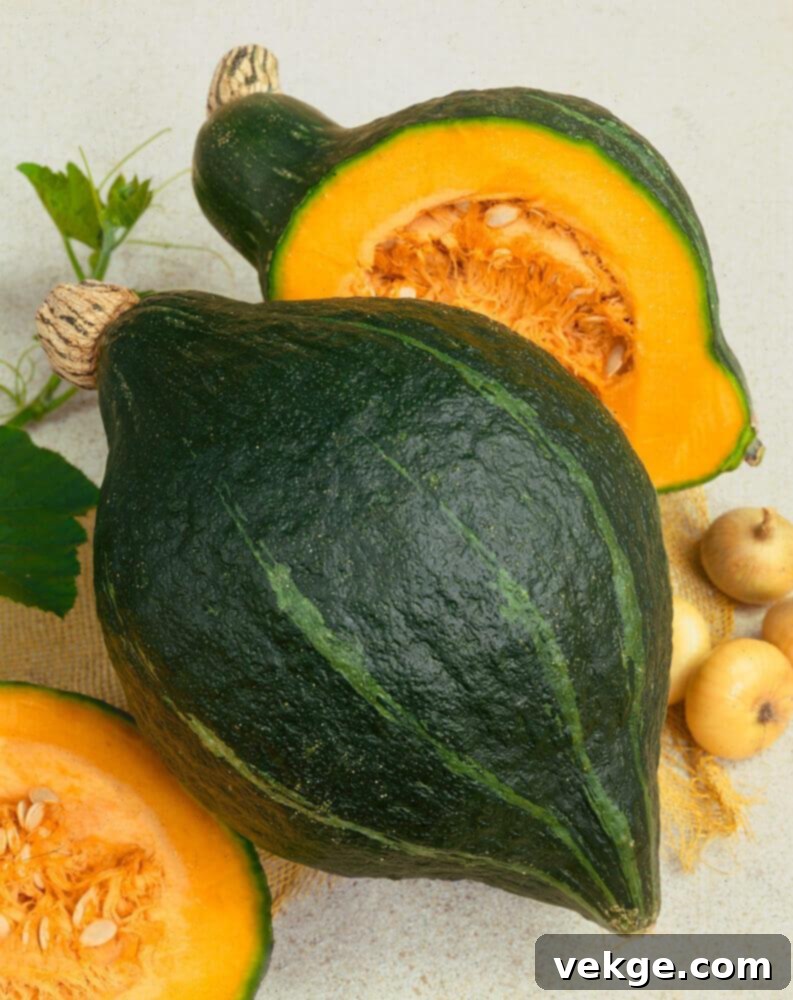
Hubbard squash is often recognized by its impressive size, irregular shape, and distinctively tough, bumpy blue-gray, green, or orange skin. When selecting a Hubbard squash, look for one that has a hard, unblemished exterior, free from soft spots or cracks. Its notoriously tough exterior is a hallmark, but also the biggest challenge in preparation. Using a strong, very sharp knife and working slowly and deliberately on a stable surface is crucial for safe cutting. A helpful trick is to soften the squash slightly by baking the whole squash briefly (about 15-20 minutes) at a moderate temperature before attempting to cut it, which can make the skin more pliable and easier to manage.
Despite its formidable exterior, the interior flesh of Hubbard squash is wonderfully sweet, nutty, and often described as having a rich, buttery texture. Its robust flavor profile makes it suitable for a wide range of dishes, excelling in both sweet and savory preparations. For sweet applications, it can be pureed and used in delectable pies, muffins, or custards, similar to pumpkin. For savory options, mash it with butter, cream, and a blend of spices like nutmeg or allspice, or incorporate it into hearty stews, rich gratins, or comforting purees and bisques. It holds its shape well in longer cooking applications.
Hubbard squash is an excellent candidate for preservation, allowing you to enjoy its flavors long after the autumn season. Once cooked, the flesh can be easily mashed or pureed and then frozen in airtight containers or freezer bags for several months, making it perfect for future soups or pies. Canning is also a viable option for longer-term storage, provided you follow safe, tested canning methods and recipes to ensure food safety and quality. Properly stored, whole Hubbard squash can last for many months in a cool, dry, dark place.
This large and versatile squash is also remarkably nutritious. It is exceptionally rich in beta-carotene, which the body efficiently converts into Vitamin A, essential for vision, immune health, and skin integrity. It also provides a significant amount of Vitamin C, a powerful antioxidant, along with other vital nutrients such as folate, potassium, and magnesium. These nutrients contribute to overall good health, supporting everything from cellular function to cardiovascular well-being, making Hubbard squash a valuable addition to your fall diet.
7. Delicata Squash: The Sweet Potato Imposter
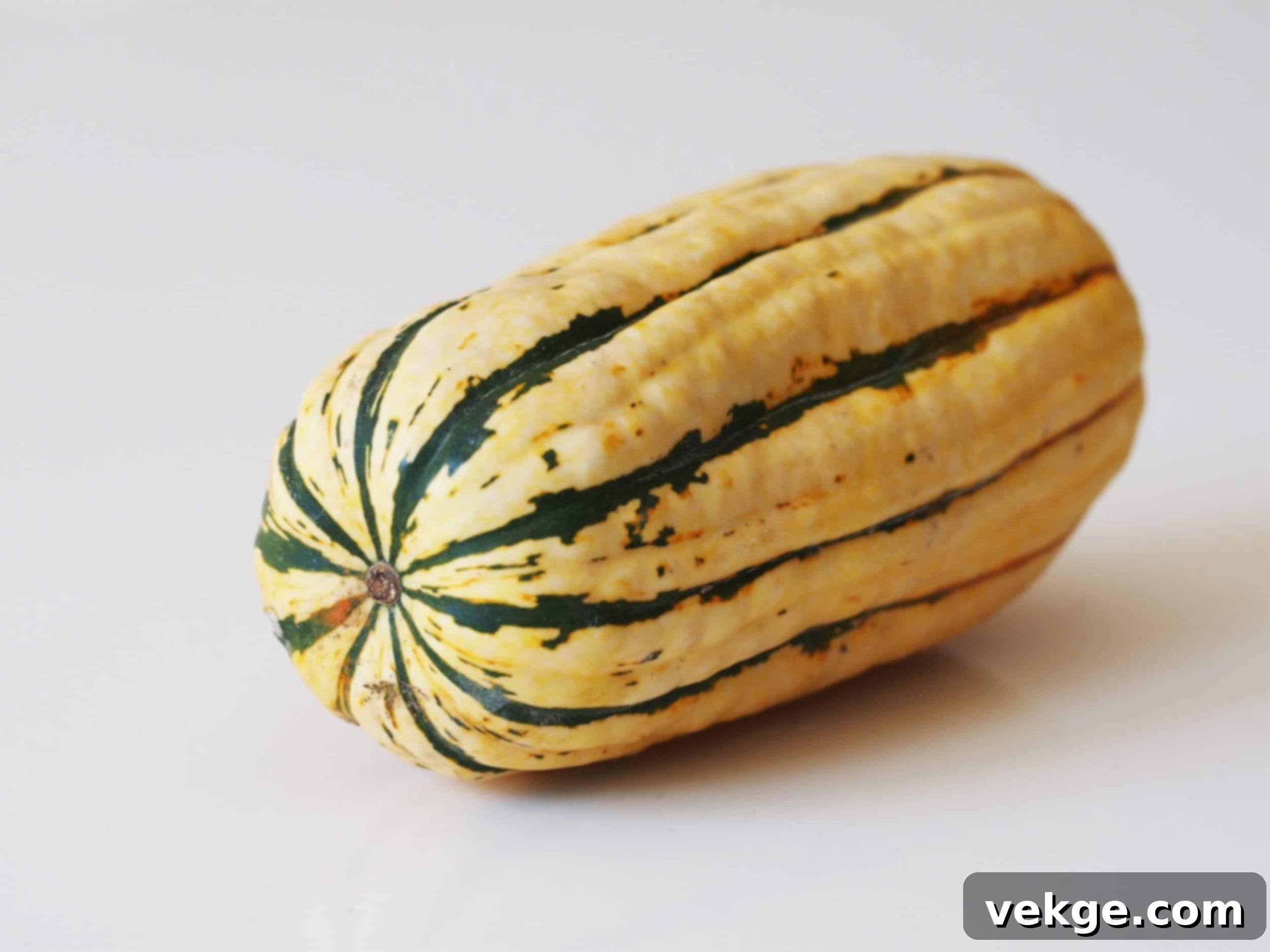
Delicata squash, true to its name, possesses a delicate flavor and texture, often compared to that of a sweet potato or corn. It’s easily identifiable by its oblong shape, creamy yellow skin, and distinctive green stripes. One of its most appealing characteristics is its entirely edible skin, which is thin and softens beautifully when cooked. This makes preparation incredibly simple and efficient—just wash, slice, and cook—eliminating the need for the often tedious peeling step that many other squashes require, saving you time and effort in the kitchen.
For a truly satisfying and flavorful fall dish, delicata squash can be thoughtfully stuffed. Try filling its roasted halves with a hearty mix of grains like farro or wild rice, sautéed vegetables, savory herbs such as thyme and sage, and perhaps some crumbled feta or goat cheese. It’s also an exceptional addition to vibrant autumn salads, providing a touch of sweetness and a pleasant chewiness. To prepare, simply slice it into half-moon shapes, toss them with a good quality olive oil, a sprinkle of sea salt, and freshly ground black pepper, then roast until the edges are beautifully golden brown and caramelized.
Roasting is arguably the best way to bring out the delicata’s natural sweetness and creamy texture. After slicing the squash into rings or half-moons, simply toss them with your favorite healthy oil (like olive or avocado oil) and an array of spices—think paprika, chili powder, or a dash of cinnamon for a sweet twist. Bake them until they are tender on the inside with slightly crispy, caramelized edges. These delightful, savory-sweet rings make an excellent, visually appealing topping for a green salad, a flavorful side dish to any meal, or even a healthy snack on their own.
Delicata squash is a fantastic source of beneficial nutrients. It is particularly rich in dietary fiber, which plays a crucial role in promoting healthy digestion, regulating blood sugar levels, and contributing to a feeling of fullness. Additionally, it offers a good supply of Vitamin A, important for vision and immune function, and Vitamin C, a powerful antioxidant that supports skin health and boosts immunity. It also contains potassium and magnesium. Incorporating delicata squash into your meals is a delicious and effortless way to enhance your nutrient intake and support overall body health.
8. Turban Squash: The Ornamental Wonder
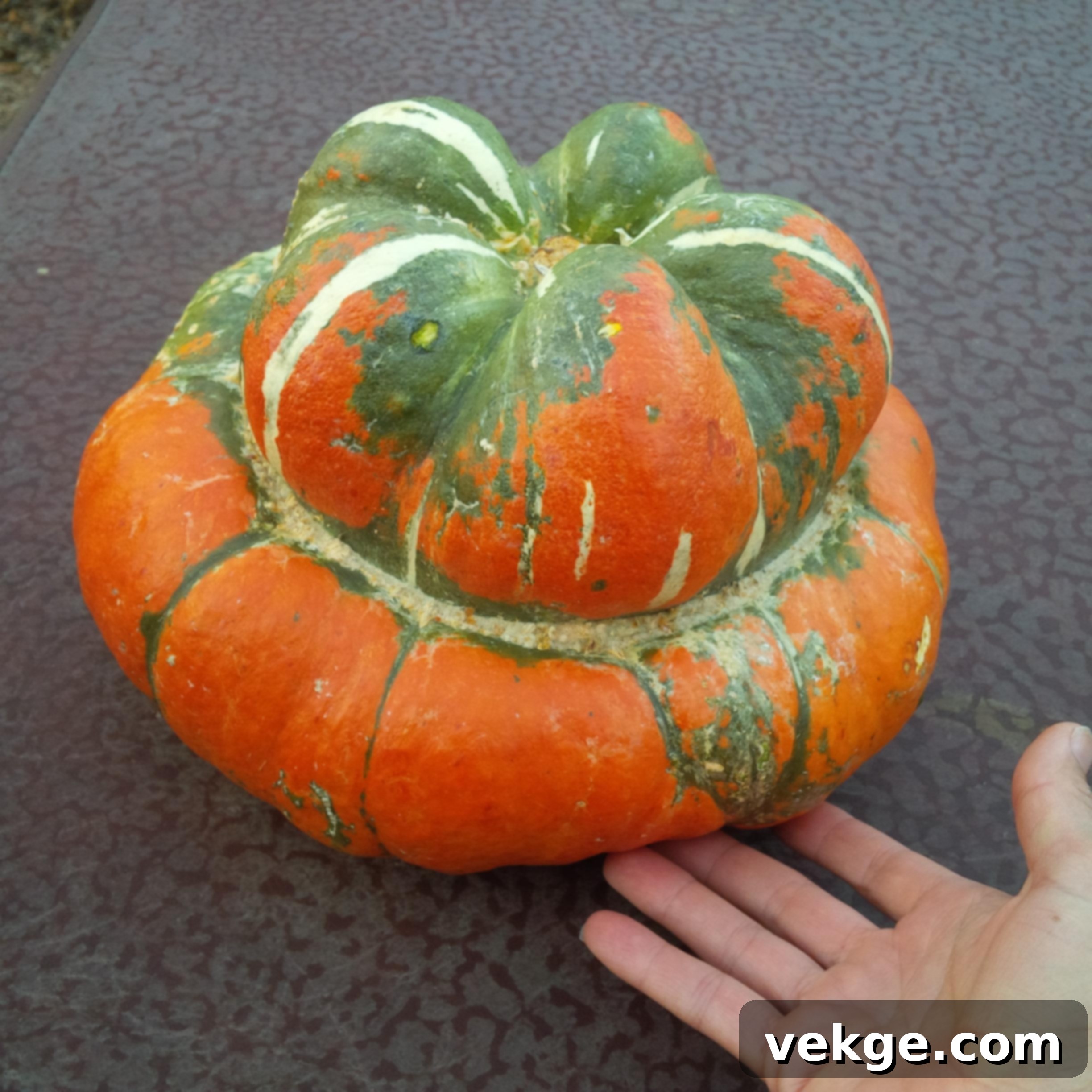
Turban squash is undeniably one of the most visually striking and whimsical members of the squash family, characterized by its distinctive “turban” or cap-like protrusion on its blossom end. With its vibrant mix of orange, green, and white hues, and its unique, often irregular shape, it makes an absolutely magnificent and eye-catching fall decoration. Utilize it as a focal point in rustic centerpieces, or mix it with other gourds, pumpkins, and autumn foliage for a truly colorful and eclectic display that celebrates the season’s bounty. Its unusual form inherently adds an element of intrigue and natural beauty to any autumn arrangement, making it a favorite for seasonal decor.
While often primarily chosen for its ornamental appeal, turban squash is, in fact, entirely edible and possesses a pleasant culinary character. It offers a mild, slightly nutty flavor profile and a texture that is somewhat similar to that of a pumpkin or butternut squash – generally firm, yet tender when cooked. It can be successfully incorporated into hearty autumn soups, adding a subtle sweetness and body. Alternatively, roasting it with savory herbs like sage and thyme, a touch of garlic, and a drizzle of olive oil creates a tasty and comforting side dish. Its unique shape can also be used as a serving bowl for soups or other cooked dishes after baking.
Turban squash boasts a rich history, having been cultivated for hundreds of years. Its unique appearance has led to it being considered a symbol of abundance and bounty during harvest time in various cultures. Its natural artistry is a testament to the diversity of the plant kingdom. The hardiness of its shell also means it can last a long time as a decoration, often through the entire fall season and beyond, making it a cost-effective and beautiful choice for seasonal embellishment.
Despite its beauty, exercise caution when preparing turban squash for consumption. Its tough skin and often uneven, irregular shape can make it quite challenging and potentially hazardous to cut. Always use a very sharp, heavy-duty knife and ensure you have a steady, non-slip surface to work on. For added safety and ease, a recommended technique is to bake the whole squash briefly in the oven to soften its exterior before attempting to cut into it. This will make the skin more pliable and handling the squash significantly safer, allowing you to access its delicious flesh with less effort and risk.
9. Ornamental Gourds: Nature’s Fall Art
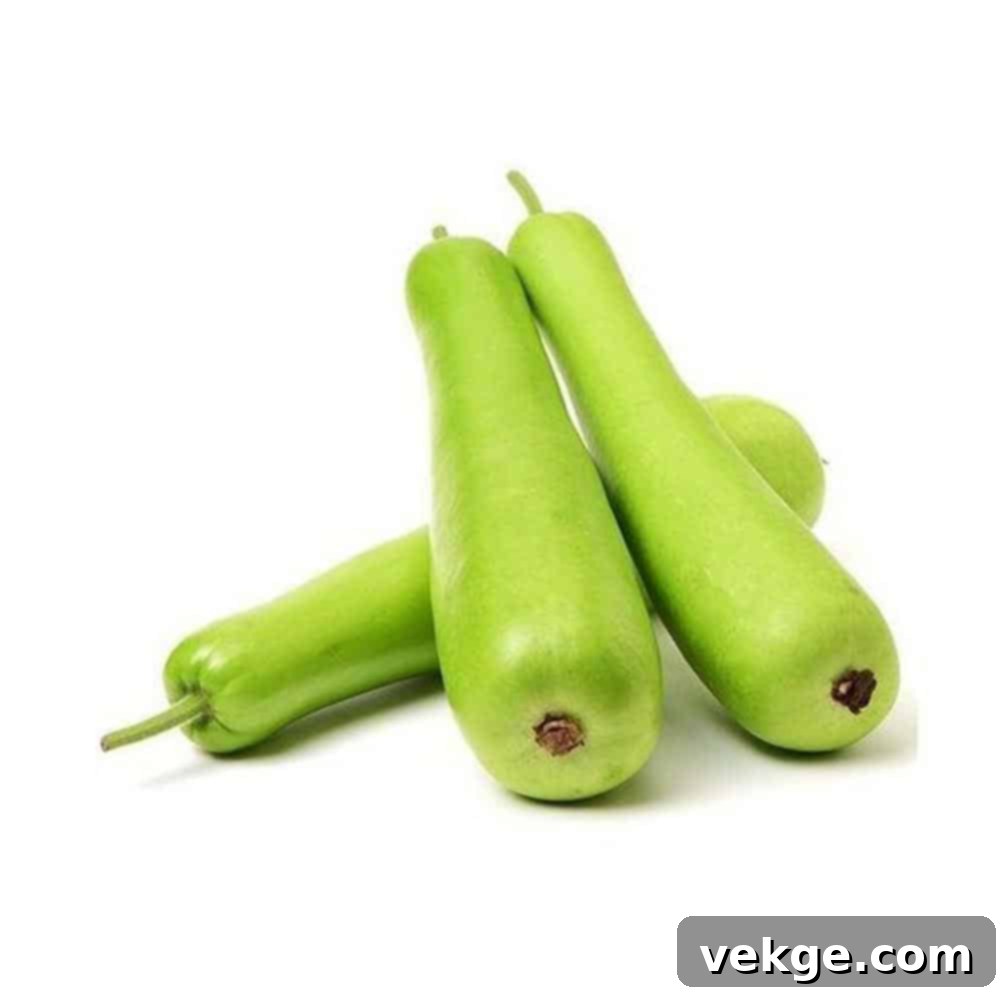
Beyond the culinary squashes, the world of ornamental gourds offers an incredible spectrum of natural artistry. These non-edible gourds are cultivated specifically for their aesthetic appeal, showcasing an astonishing variety of shapes, sizes, and vibrant colors. You’ll discover charming small, bumpy ones that fit in the palm of your hand, alongside large, smooth specimens. Some mimic the elegant form of pears, while others boast long, slender, or wonderfully curvy necks, creating a whimsical and diverse collection that captures the essence of autumn’s beauty. Their imaginative forms are truly nature’s sculpture.
Ornamental gourds are a fantastic medium for creativity and crafts, appealing to all ages. Their hard shells provide a durable canvas for various artistic endeavors. You can transform them by painting them with festive designs, intricate patterns, or even simple block colors to match your decor. Larger gourds can be carefully hollowed out and dried to become unique birdhouses, offering a cozy retreat for feathered friends. Smaller, sturdier ones can be repurposed into charming decorative bowls or planters. With just a little imagination and some basic craft supplies, they can be fashioned into unique decorations, thoughtful handmade gifts, or engaging projects for children.
For simple yet stunning fall decor, mix these diverse gourds with other seasonal elements. Arrange them alongside colorful autumn leaves, fragrant pinecones, and warm flickering candles to create an inviting tablescape or a cozy mantel display. For a more understated but equally pretty arrangement, gather an assortment of different sizes, shapes, and colors of gourds and place them artfully in a rustic basket, a wooden bowl, or simply scatter them across a console table. Their natural beauty speaks volumes and instantly brings the warmth of autumn indoors.
To ensure your beautiful ornamental gourds last for a long time, allowing you to enjoy them year after year, proper curing and drying is essential. This process involves allowing them to dry out completely, which can take several weeks to many months, depending on their size and environmental conditions. Store them in a cool, dry, well-ventilated area until they become light and hard, and any remaining moisture has evaporated. Once fully dry, gently clean them with a soft cloth to remove any dust or debris. With proper care, these natural decorations can become cherished elements of your fall decor tradition for many seasons to come, a sustainable and beautiful choice.
10. Carnival Squash: A Festive Fall Treat

Carnival squash is a delightful hybrid that truly lives up to its festive name, with its vibrant speckled and striped skin showcasing a mix of green, orange, and yellow. Its flavor profile is equally exciting, offering a delectable blend that is often described as a cross between sweet potato and corn, with distinct hints of maple. It strikes a perfect balance, generally sweeter than acorn squash but not quite as intensely sweet as butternut, making it a wonderfully approachable and versatile choice for many palates. Its creamy, tender flesh makes it a favorite for a variety of culinary applications.
This charming squash is fantastic for adding both flavor and color to your autumn dishes. Try incorporating it into a vibrant fall salad: roast cubes of carnival squash until tender and caramelized, then toss them with fresh greens, crunchy pecans or walnuts, dried cranberries, and a tangy maple vinaigrette for an explosion of seasonal flavors and textures. It’s also excellent when pureed into creamy soups, mashed with a touch of butter, brown sugar, and warming spices, or roasted simply as a beautiful and delicious side dish. Its unique flavor complements both sweet and savory ingredients equally well.
Preparing carnival squash is straightforward. Begin by carefully cutting the squash in half lengthwise and scooping out the seeds and fibrous strands. For roasting, place the halves cut-side down on a baking sheet and bake until the flesh is soft and easily pierced with a fork. Once cooked and flipped over, the hollowed-out halves become perfect edible bowls, ready to be filled with a variety of delicious stuffings. Consider a mix of seasoned grains, your favorite cheese, sautéed vegetables, or even ground meat for a complete and visually appealing meal that is both hearty and healthy.
Carnival squash is not just a treat for the taste buds; it’s also packed with beneficial nutrients, making it a smart choice for healthy eating during the fall season. It is notably high in dietary fiber, which is crucial for promoting healthy digestion, helping to regulate blood sugar levels, and contributing to a sustained feeling of fullness, which can aid in weight management. Furthermore, it provides a good source of vitamins A and C, powerful antioxidants that boost your immune system, support vision, and promote healthy skin. Being low in calories, it allows you to enjoy its rich flavor guilt-free while nourishing your body.
Summing It Up: Embrace the Autumn Harvest
As we conclude our delightful exploration of autumn’s bounty, we’ve journeyed through the diverse world of gourds and squashes, from the universally recognized pumpkin to the less common but equally delicious delicata and the visually stunning turban squash. Each variety, with its unique characteristics, brings something truly special and enriching to our kitchens, our palates, and our homes during this magical season.
These incredible gourds and squashes offer far more than just a foundation for delicious meals. They infuse our dishes with a spectrum of vibrant colors, contributing to the visual feast of autumn. Beyond their aesthetic appeal, they significantly boost our health with their impressive array of vitamins, minerals, and antioxidants. Moreover, they play a pivotal role in transforming our homes into cozy, inviting, and festively decorated spaces, truly embodying the spirit of fall. They are, without a doubt, a significant and cherished part of what makes this time of year so uniquely special and memorable.
The next time you find yourself strolling through a farmers market or the produce aisle, we encourage you to step outside your comfort zone. Why not pick up a gourd or squash variety you’ve never tried before? You might just uncover a new culinary favorite that will revolutionize your autumn cooking or discover a decorative gem that adds unexpected charm to your seasonal displays. The possibilities are truly endless when it comes to experimenting with these versatile fruits of the harvest.
There are countless delightful ways to utilize these autumnal treasures, from simmering them into rich, comforting soups and stews, baking them into sweet and savory pies, to crafting beautiful and rustic centerpieces that capture the essence of the season. Let the abundance and beauty of these fall gourds and squashes inspire you to try new recipes, experiment with innovative flavor combinations, and make your home a truly cozy, welcoming, and festive haven for the season. Embrace all that fall has to offer, and let its natural gifts bring joy to your table and your home.
Have a wonderful, flavorful, and beautifully decorated autumn!
